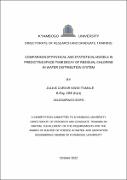| dc.contributor.author | Kwio-Tamale, Julius Caesar | |
| dc.date.accessioned | 2023-02-10T08:23:18Z | |
| dc.date.available | 2023-02-10T08:23:18Z | |
| dc.date.issued | 2022-10 | |
| dc.identifier.citation | Kwio-Tamale, Julius Caesar(2022) Comparison of physical and statistical models in predicting space-time decay of residual chlorine in water distribution system | en_US |
| dc.identifier.uri | https://hdl.handle.net/20.500.12504/1208 | |
| dc.description | xviii,127p.:ill (some col) | en_US |
| dc.description.abstract | Chlorine is the most widely used disinfectant in water distribution due to its efficacy,
ease of application, low cost and extended disinfection durability. The World Health
Organization recommends concentrations of residual chlorine in drinking water to be
within 0.2 – 5 mg/l. Concentrations lower than 0.2 mg/l expose water consumers to
secondary water-borne diseases. Chlorine concentrations more than 5 mg/l expose
consumers to carcinogenic disinfection by-products. Studies on comparative analysis
of performance of physical and statistical models in predicting chlorine decay in
drinking water distribution system are lacking. The specific objectives of this study
were: (1) characterization of residual chlorine decay parameters in water distribution,
(2) assessment of space-time decay of chlorine in water distribution, (3) comparison
of performance of models in predicting chlorine decay in water distribution and (4)
identification of appropriate model(s) for predicting chlorine decay in water
distribution system. Performance of EPANET physical model was compared with
statistical models of multiple linear regression (MLR), principal component regression
(PCR), lasso regression (LR), ridge regression (RR), decision tree (DT), random forest
(RF) and artificial neural network (ANN). ANN performed best with R2 of 94%
followed by MLR (63%), PCR (61%), RF (55%) and DT (41%). Initial chlorine and
electrical conductivity were the two most significant parameters in water distribution
that together contributed to about 90% of chlorine decay. Based on generalizability,
dimensionality control and interpretability as desired factors for a good model, linear
regression with R-squared of 63% and 0.045 mg/l error estimate performed best in
predicting residual chlorine. Water zoning is recommended with existing water
reservoirs as secondary chlorination points to maintain residual chlorine
concentrations within 0.2 – 5 mg/l. In return, high and low dosages that cause
carcinogenic disinfection by-products and predispose public health to secondary
pathogenic infectious water-borne diseases respectively will both be avoided throughout water distribution network | en_US |
| dc.language.iso | en | en_US |
| dc.publisher | Kyambogo University[unpublished work] | en_US |
| dc.subject | Satistical models. | en_US |
| dc.subject | Residual chlorine. | en_US |
| dc.subject | Water distribution system. | en_US |
| dc.title | Comparison of physical and statistical models in predicting space-time decay of residual chlorine in water distribution system | en_US |
| dc.type | Thesis | en_US |

